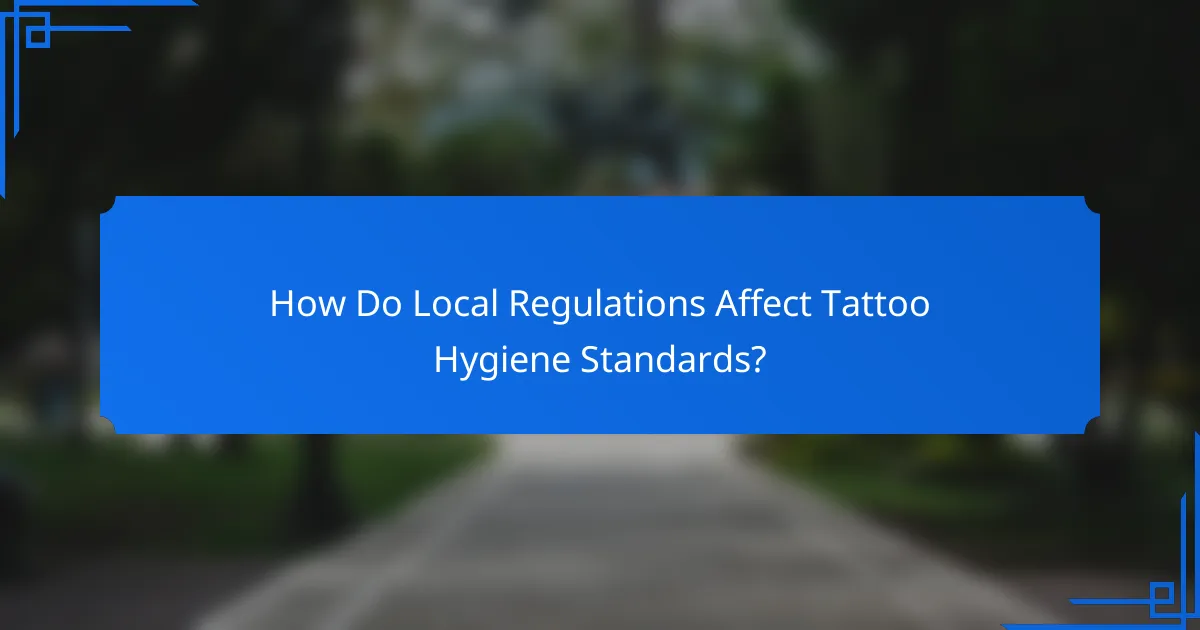Choosing the right tattoo artist is crucial for a safe and satisfying experience, and being aware of red flags can help you make an informed decision. Key warning signs include hygiene issues, insufficient experience, and poor communication, which can all lead to unsatisfactory results and health risks. By paying attention to these factors, you can ensure that your tattoo journey is both enjoyable and safe.

What Are the Red Flags in Tattoo Artists?
Red flags in tattoo artists include hygiene issues, lack of experience, poor communication, unprofessional behavior, and an inconsistent portfolio. Identifying these warning signs can help ensure a safe and satisfactory tattoo experience.
Hygiene issues
Hygiene is critical in tattooing, as poor practices can lead to infections and other health risks. Look for clean workspaces, sterilized equipment, and the artist wearing gloves. If the studio appears dirty or the artist does not follow proper sanitation protocols, consider this a significant red flag.
Check for visible cleanliness in the tattoo area, including surfaces and tools. Ensure that single-use items, such as needles and ink caps, are used and disposed of properly.
Lack of experience
A tattoo artist’s experience can greatly affect the quality of your tattoo. If an artist is new to the profession, they may lack the skills necessary to execute your desired design effectively. Look for artists with a portfolio that showcases a variety of styles and techniques.
Consider asking about their training and how long they have been tattooing. Artists with a few years of experience and positive reviews are generally more reliable than those just starting out.
Poor communication
Effective communication is essential for a successful tattoo experience. If an artist struggles to understand your ideas or fails to provide clear answers to your questions, this could lead to misunderstandings and dissatisfaction. A good artist should listen to your concerns and offer professional advice.
Pay attention to how responsive they are during your initial consultations. If they are dismissive or unengaged, it may indicate a lack of professionalism.
Unprofessional behavior
Unprofessional behavior can manifest in various ways, such as being late for appointments, showing a lack of respect for clients, or having a disorganized workspace. These behaviors can indicate a lack of commitment to their craft and your satisfaction.
Observe how the artist interacts with clients and staff. A respectful and professional demeanor is crucial for a positive tattoo experience.
Inconsistent portfolio
An inconsistent portfolio may suggest that an artist lacks a specific style or the ability to execute designs reliably. Review their previous work carefully to ensure they can deliver the quality and style you desire. Look for a cohesive body of work that demonstrates their skills across various designs.
If you notice significant variations in quality or style, it may be wise to seek another artist. A strong portfolio should reflect their best work consistently, indicating their expertise and reliability.

How to Identify Hygiene Red Flags?
To identify hygiene red flags in tattoo artists, look for signs of cleanliness, proper sterilization, and the use of disposable items. A lack of attention to these areas can indicate potential health risks and poor practices.
Unclean workspace
A clean workspace is essential for safe tattooing. Check for visible dirt, clutter, or stains on surfaces, as these can harbor bacteria. The area should be organized and free of unnecessary items that could contaminate the environment.
Pay attention to the floors, tables, and equipment. If the artist does not maintain a tidy space, it may reflect their overall hygiene practices. A reputable artist will prioritize cleanliness and create a welcoming atmosphere.
Improper sterilization techniques
Proper sterilization techniques are crucial to prevent infections. Ensure that the tattoo artist uses an autoclave or similar device to sterilize reusable tools. If they mention using chemical solutions instead, be cautious, as this may not be sufficient.
Ask about their sterilization process. A professional should be able to explain how they ensure all equipment is clean and safe for use. If they seem unsure or dismissive, consider it a red flag.
Use of disposable items
The use of disposable items is a standard practice in the tattoo industry to minimize contamination risks. Check if the artist uses single-use needles, gloves, and ink caps. These items should be opened in front of you to ensure they are new and sterile.
Be wary of artists who reuse items or do not offer disposable alternatives. Using disposable supplies is a simple yet effective way to enhance hygiene and protect both the artist and the client from infections.

What Experience Levels Should You Look For?
When selecting a tattoo artist, consider their experience level as a key factor in ensuring quality and safety. Look for artists with several years in the industry, a strong portfolio, and positive client feedback to gauge their expertise and reliability.
Years in the industry
Experience in the tattoo industry can significantly impact the quality of your tattoo. Artists with at least three to five years of experience are often more skilled and knowledgeable about techniques, hygiene practices, and customer service. However, some newer artists may also be talented, so consider their training and mentorship as well.
It’s essential to ask about the artist’s background and any specialized training they have received. A seasoned artist will likely have a deeper understanding of skin types, healing processes, and how to execute various styles effectively.
Portfolio quality
A tattoo artist’s portfolio is a crucial indicator of their skill and style. Review their work to ensure it aligns with your vision and preferences. Look for consistency in quality, attention to detail, and a variety of styles that demonstrate versatility.
Pay attention to healed tattoos in the portfolio, as they provide insight into how the artwork looks after the healing process. A good portfolio should also include a range of designs, showcasing the artist’s ability to create custom work tailored to individual clients.
Client testimonials
Client testimonials can offer valuable insights into an artist’s professionalism and customer satisfaction. Look for reviews on social media, tattoo forums, or the artist’s website to gauge the experiences of previous clients. Positive feedback often highlights the artist’s communication skills, cleanliness, and ability to create a comfortable atmosphere.
Consider reaching out to past clients for personal recommendations or insights about their experiences. This can help you make a more informed decision and ensure you choose an artist who meets your expectations for quality and service.

How Important Is Communication with Your Tattoo Artist?
Communication with your tattoo artist is crucial for ensuring your vision is accurately translated into body art. Effective dialogue helps clarify expectations, address concerns, and establish a trusting relationship throughout the tattooing process.
Understanding your vision
To achieve the desired outcome, your tattoo artist must fully understand your vision. This involves discussing design elements, colors, and placement in detail. Providing reference images can significantly enhance this understanding and help the artist visualize your ideas.
Be open to suggestions from your artist, as they may offer valuable insights based on their experience. This collaborative approach can lead to a more refined and satisfying final design.
Providing clear aftercare instructions
Aftercare is essential for the healing process and the longevity of your tattoo. A good tattoo artist will provide clear, detailed aftercare instructions, including how to clean the tattoo, what products to use, and what activities to avoid during the healing period.
Make sure to ask questions if any part of the aftercare process is unclear. Proper aftercare can prevent infections and ensure the tattoo heals beautifully, preserving the artist’s work.
Responding to concerns
Your tattoo artist should be approachable and responsive to any concerns you may have before, during, and after the tattooing process. If you feel uneasy about any aspect of the tattoo, such as pain levels or design adjustments, communicate these feelings openly.
A professional artist will address your concerns with empathy and provide reassurance. This open line of communication fosters a positive experience and can help alleviate anxiety, ensuring you feel comfortable throughout the process.

What Are the Prerequisites for Choosing a Tattoo Artist?
Choosing a tattoo artist requires careful consideration of hygiene practices, experience, and communication skills. Prioritizing these factors can help ensure a safe and satisfying tattoo experience.
Researching artist credentials
Start by verifying the artist’s credentials, including their training and certifications. Many reputable tattoo artists have completed formal apprenticeships and hold certifications in bloodborne pathogens and safety standards.
Look for artists who are licensed in your area, as this often indicates they adhere to local health regulations. For example, in the United States, many states require tattoo artists to be licensed and follow specific hygiene protocols.
Checking online reviews
Online reviews can provide insight into an artist’s reputation and customer satisfaction. Websites like Yelp, Google Reviews, and social media platforms often feature feedback from previous clients, highlighting both positive and negative experiences.
Pay attention to comments about hygiene, professionalism, and the quality of the artwork. A consistent pattern of positive reviews can indicate a reliable artist, while multiple complaints about cleanliness or communication should raise red flags. Aim to read a range of reviews to get a balanced perspective.

How Do Local Regulations Affect Tattoo Hygiene Standards?
Local regulations play a crucial role in establishing tattoo hygiene standards, ensuring that artists maintain a safe and clean environment. These regulations often dictate the practices that tattoo studios must follow to protect clients from infections and other health risks.
Health department guidelines
Health department guidelines set the baseline for hygiene practices in tattoo studios. These guidelines typically cover sanitation protocols, including the sterilization of equipment, cleanliness of the workspace, and proper disposal of waste materials. Compliance with these standards is essential for minimizing the risk of infections.
For example, many health departments require the use of single-use needles and ink containers to prevent cross-contamination. Studios should display their health department certificates prominently to assure clients of their adherence to these guidelines.
Licensing requirements
Licensing requirements for tattoo artists vary by location but generally include proof of training in hygiene and safety practices. Many jurisdictions require artists to complete a certification course that covers bloodborne pathogens and infection control. This ensures that artists are knowledgeable about the health risks associated with tattooing.
Additionally, studios must often obtain a business license and a health permit, which may require regular inspections. Clients should verify that their chosen artist and studio are properly licensed to ensure compliance with local regulations.


